Green products are those with lower power consumption footprints, through either improving efficiency or by harvesting renewable energy. This interview focusses on potential ways to make your product greener.
Puneet Shukla, CEO, Saison Components and Solutions talks to Sneha Ambastha and Pankaj Vashisht

Q. what according to you is the most exciting component that could help renewable energy industries?
A. Supercapacitors or ultracapacitors are not only excellent source of power backups but can also be used to stabilise voltage in fluctuating load conditions. Wind power plants use supercapacitors to provide backup power for actuators in wind turbine pitch systems, so that blade pitch can be adjusted even if the main supply fails. In solar power plants, photovoltaic (PV) systems exhibit fluctuating loads evoked by clouds that supercapacitors can buffer within milliseconds. This reduces the need to stabilise grid voltage and frequency, balance supply and demand of power and manage real or reactive power.
Q. What are the most important design considerations for energy storage devices, irrespective of application?
A. Energy storage devices are now used in various industries from a simple toy to heavy industrial robots. Design considerations vary from product to product, but it is very important for any designer to keep in mind the temperature effects and thermal properties which can change their performance over time. It is important to understand that lifetime and efficiency are the major concerns that decide the usefulness of the energy storage device.
Q. How can an engineer improve the efficiency of the energy storage devices?
A. By increasing the surface area of electrodes, which can be achieved after replacing activated carbon electrode with graphene electrode. Because graphene has substantially more surface area so using it for storing electrostatic charge would be better.
Q. What are the critical design considerations for manufacture of LED products?
A. LEDs are luminaries and design engineers have three key issues to focus upon, that is, how bright it is? What power it consumes? And what is its luminance distribution? Brightness or luminance is measured in terms of luminous flux or lumens. Power is generally expressed in watts as we all know, but lumens per watt or luminous efficacy is the key point on which an LED product is compared with other luminaries. The distribution of light is another important issue for lighting products; omnidirectional is important for most solutions, as people want light to be distributed like an incandescent bulb.
Q. How can designers improve luminous efficacy in LED products?
A. Luminous efficacy is a property of light source that indicates what portion of the emitted electromagnetic radiation is usable for human vision. It is the ratio of emitted luminous flux to radiant flux. By using convection cooling, we can improve the thermal performance of lamps and efficiently reduce LED junction temperature, thereby improving luminous efficiency.
Q. When we talk about LED lighting products, how important is CRI? How it is calculated?
A. CRI or colour-rendering index is an important parameter when we talk about primary LED lighting products that are to replace traditional lights. It describes how a light source makes the colour of an object appear to human eyes, thereby defining the quality and consistency of the LED light. CRI has a scale from 10 to 100 per cent, indicating how accurate a given light source is at rendering colour compared to reference light source. The higher the CRI, the better the colour-rendering ability.
CRI is calculated by measuring the difference between the lamp in question and a reference lamp in terms of how they render the eight colour samples. If the lamp to be tested has a correlated colour temperature (CCT) of less than 5000 Kelvin (K), the reference source is a black body radiator (approximately like an incandescent lamp).
Q. What are the technologies available to build for obsolete semiconductors?
A. Everyday advancement in technology has shortened the semiconductor’s life cycle but we have many technologies available ensuring their continued support and quality of build through original manufacturers’ assembly, testing and custom package designs. There are a number of standard and custom mechanical re-working services available for existing or damaged components.
Pankaj V. and Sneha A. are technical journalists at EFY







